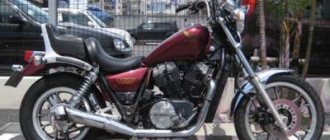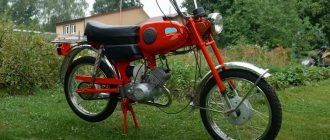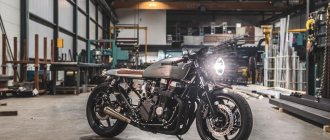Bike features
Here are the main features of the Honda VFR 400:
- small capacity;
- good handling;
- true belonging to the class of sports motorcycles.
It is worth dwelling on the last point. The fact is that recently there have been a lot of bikes that are not actually sports bikes, but they look almost like them and the characteristics are quite similar. However, the real “sport” is easy to recognize just by looking at its exterior and contents.
text:
Petr Verkhovtsev,
photo:
Dmitry IvaikinHonda VFR400R: 399 cm3, 59 hp, 180 km/h, produced 1991-1996, $ 3500-4500
Kawasaki ZXR400R: 398 cm3, 59 hp, 180 km/h, produced 1991-1995, $3400-4300
Why do people love 400 cm3 sportbikes besides the price? For lightness and true sporting character. Any “liter” will always have an elastic characteristic, no matter how much it is forced. On the “400” everything is fair: dips and pick-ups, uncompromising handling and a weight of less than 160 kg.
Let me make a reservation right away, we will talk specifically about sportbikes, and not about motorcycles similar to them - Kawasaki ZZ-R, Suzuki RF and the like. And how many of these exist in nature? If we talk about motorcycles with a real sports bent, then there are four: Suzuki GSX-R400, Honda CBR400RR, Honda VFR400 and Kawasaki ZXR400. The first motorcycle is extremely rare: as far as I can remember, no more than a dozen of them have been imported over the past four years. The CBR, a small FireBlade, is deservedly considered the leader in the class, and no self-respecting dealer in good condition will be lucky enough to have one - otherwise he will set a price of at least $ 5,000. But VFR and ZXR, on the contrary, can be bought in completely working condition - and get away with it at $4000.
Small size If you get acquainted with these motorcycles without regard and from a certain distance, they evoke only respect: equipped with all the sportbike attributes, they seem capable of anything. The Kawasaki looks especially sophisticated: the corrugated hoses of the inertial boost system, the inverted fork and the very modern design make it hard to miss. Honda looks simpler: funny round headlights and square brake lights send back to the 80s, and the massive “tail” is simply ugly. The cantilever suspension of the rear wheel with a massive one-sided pendulum and the “racing” coloring add solidity.
But once you put them next to any regular motorcycle, the “child size” becomes noticeable even before you get behind the wheel of any of them. I don’t know how tall the average Japanese person is, but with my 183 cm, both devices turned out to be simply cramped. Moreover, the Honda feels very small. For the experiment, I placed my feet on the footrests endur-style, on my toes, with my heels almost reaching my hips! Well, okay, I’ll try to close my eyes to this, if, of course, it works out. Low steering wheel clip-ons, a small piece of glass, in my opinion, it is akin to a “fifty kopeck”. After half an hour of driving, I somehow sat down on the VFR and decided to ride the Kawasaki. Here the situation is better - the motorcycle is longer, the seating position is not so tight. However, it turned out to be too small for me. I’m afraid to even imagine why both motorcycles have passenger footrests - I’m imagining a circus, if you put a person at least 190 cm tall on the back - will it work? However, such motorcycles are not bought for passengers, so let’s leave quibbles aside.
Honda makes it clear right away that it is a Honda. Relatively comfortable, with well-thought-out ergonomics, the motorcycle pleases with such little details as clear gear shifting, comfortable levers (the brake is adjustable) and clear steering switches. Kawasaki is not lagging behind - everything on it is also quite comfortable. The twin lights on the dashboard look funny. But, even without making allowances for the fact that the VFR is more compact, for some reason it is more comfortable to sit on it. On the ZXR my legs started to go numb pretty quickly. In general, the Kawasaki feels much more rigid: the absolutely jaw-dropping tuning of its suspensions even forced us to reshoot the photo shoot. To keep the bike from shaking like a shaker, we softened the damping of both the front fork and the rear monoshock. And this was good for the motorcycle: I think that if you drive 150 kilometers with hard settings, you can easily break something off for yourself. Honda is clearly preferable in this regard.
It's all about the engine What does the average user look at when choosing a motorcycle? On engine power. Here, at first glance, it is spared the agony of choice: the power of both is 59 hp. - this is the value to which the power of any motorcycle in the 400 cm3 class is limited. By the way, both devices were supplied to Europe both through official channels and through the efforts of parallel importers. Our experimental subjects arrived straight from the Land of the Rising Sun. Alas, not everything is so simple, and this is clear from the moment we set off. Honda pulls from the very bottom, clearly demonstrating the advantage of the V4 circuit. And these are not loud words - decent traction allows you to lift the front wheel into the air from the gas, of course, in first gear and at an engine speed of 6000 rpm. On Kawasaki, this number can only be achieved using the clutch. And even then on the verge of reason.
As a matter of fact, engines make a huge difference between motorcycles. The ZXR's powertrain demonstrates true sporting character. A serious “drawdown” at low speeds and a very noticeable pick-up at 10,000 rpm (the red zone starts at 14,500 rpm) eloquently hints that novice pilots will have a hard time on the motorcycle.
Here lies the main contradiction: according to existing stereotypes, any “four hundred” is a motorcycle for beginners. We have a different case: it would be hard to recommend the ZXR to a beginner. And not only because of the evil engine. Honda seems like a good boy against this background. While demonstrating a very uniform characteristic. However, this uniformity ultimately benefits the acceleration dynamics: the VFR accelerates noticeably more vigorously than the ZXR. These same features also determine the characteristics of the motorcycles: with a more extreme landing position, it is even easier to ride on a Honda. It requires less concentration from the driver. This is noticeable if you ride motorcycles one by one for 100 kilometers. In my case, the route ran from Mytishchi to Sergiev Posad - along a fairly wide road, but congested with traffic.
Sports and life Unfortunately, it is extremely difficult to ride on a specialized track in Russia, so most sport bikers realize the capabilities of powerful equipment on public roads. And very good: what motorcycle is suitable for sudden changes in direction of movement, if not a sportbike! And in our case, also a short-wheelbase sportbike! Need I say that on city streets both tested “400” cars feel as good as possible and even more confident than their “liter” counterparts? So we take a motorcycle with a partner and head straight to the city center.
The Kawasaki, as I expected, exhibits a more extreme character. Making my way between the rows, I note that driving slowly is not very convenient - you have to use the clutch and want to put your feet out all the time. The low weight and short wheelbase of the motorcycle make themselves felt - changing lanes is as easy as on a scooter. There is no trace of that feeling of tightness and limited maneuverability that I know from heavier motorcycles. I remembered my Bandit with horror - I try to avoid driving it on busy streets. As soon as it is possible to accelerate to at least 100 km/h, the ZXR becomes quite adequate - the pickup ceases to dominate over everything else, you can concentrate on driving. Eh, often, very often you have to click through gears - the narrow range of decent power does not allow you to relax. Of course, this is not a two-stroke, but it is not a “six hundred” either. And so they went, went... Four sportbikes - two FireBlades and two R1s overtook us like we were standing. It's a shame, of course, but nothing can be done.
Kawasaki demonstrates true sporty handling. The rigidity of the chassis seems excessive, and the angle of the steering column is not great. Because of this, management suffers from excessive sharpness. Fortunately, the asphalt would be smooth. You know, when you come out of a corner with good acceleration - the front wheel is unloaded - and then you inaccurately release the gas and, God forbid, the front wheel hits an uneven surface, the green starts to wobble so much that you want the most powerful steering damper . And this, you see, is not the first purchase that a person who buys a budget motorcycle will make.
The situation was slightly improved by changing the suspension adjustment: at the front I weakened the rebound to a minimum (the only hydraulic adjustment), at the rear I also weakened the rebound and preload of the spring. The motorcycle's reactions lost their excessive sharpness, and the wobbles on bumps became smaller. Although they didn't disappear completely. In my opinion, it is the Kawasaki that gives the feeling of that very “reference tool” expected from a sportbike. And not without the help of brakes: both the front and rear are not only effective, but also perfectly controlled. VFR lags behind in this regard: it is very difficult to feel the moment the rear wheel locks.
Having sat down on the Honda after the “green vibration test”, I experienced a terrible surprise: the motorcycle differs from its opponent much more than it seems at first glance. The suspension is tuned more humanely, the rigidity of the chassis is familiar - even the fork is not upside down. Of course, the engine plays a role, which, subjectively, seems more powerful. Maneuvering in traffic jams is easier than on the Kawasaki. But... A very strange problem appeared. If the ZXR is, after all, perceived as a motorcycle and does not seek to seriously infringe on its rights, then with Honda things are worse. Maybe the red and blue coloring has an effect, or the frivolous round headlights, I don’t know. Or maybe it’s the overall compactness of the motorcycle, which makes me look like a bear on a tricycle. Of course, this reduces the pleasure of driving.
Remove the limiters! The second day came to an end, the cars went home and - here it was - the Moscow Ring Road at night. What are these “real sportbikes” capable of? I crank the Honda engine until it squeals, it’s in fifth gear, the tachometer needle tends to the red zone, which occurs at 13,500 rpm, the speedometer needle exceeds 180 km/h, and the speed cutoff occurs. I experienced similar sensations during the test of the exclusive CBR400RR six years ago. It's a shame when the power potential is not fully used. What's even more frustrating is that removing this restrictor can be a difficult task.
After 170 km/h, the Kawasaki accelerates noticeably worse than the Honda, but, nevertheless, it also hits the speed limiter in the same fifth gear.
In Europe, they are familiar with this problem - ordering new switches that remove speed restrictions is commonplace. There is a selection of other tuning components. Alas, this is difficult to access in Russia. However, ordering any original spare parts does not present any difficulties - both motorcycles are quite common. The only thing you should be wary of is ordering spare parts from European versions of cars. It may very well turn out that if you install a “European” switch on the Japanese version of the motorcycle, the engine simply will not start.
The most pleasant speed while driving both motorcycles is 150-160 km/h. Wind protection is still effective and steering response is quite sharp. And any of these devices will allow the most complex maneuver much more quickly than heavier “liters”.
Selection criteria I will express my thoughts, forgetting about the problems with the size of motorcycles. On the one hand, they are quite suitable as the first sports bikes-simulators. After a season behind the wheel of any of them, you can safely decide on further growth: whether to switch to a “six hundred”, but if you don’t like turning the engine, and speeds “over 250” give you no rest, choose something with a liter. On the other hand, I would be careful about buying any of these motorcycles as a first: they are too obligatory. It is no secret that of the highly “decomposed” “four hundred” our test subjects are found much more often than the mentioned RF and ZZ-R. If you still want to start with just such a motorcycle, choose the VFR. The third party is the price and cost of operation. $4000 is not a small amount in itself, and don’t forget about the tires, which will have to be changed a couple of times a season, and about the pads, and about the plastic, which is very easy to spoil. These parts are no cheaper than similar ones from large sportbikes.
And further. When buying such motorcycles in the heat of the moment, do not forget about their technical condition! Bright colors sometimes hide not only defects, but also severe wear. It's no secret that many of them were used in amateur racing with all the ensuing and falling off consequences.
Dimensions and weight
The weight of the model is 164 kg. Tank volume – 15 l. The wheelbase of this fairly compact machine is 1345 mm, which is not surprising, since sports motorcycles are usually always quite small, not counting sports tourists. A motorcycle consumes 6-7 liters of gasoline per 100 km, however, this is not so important, because people who buy a sports bike are probably the last thing they think about is fuel consumption.
FAQ on Honda VFR400R (nc30, nc24, nc21 and K modifications)
Fresh, exclusive, question-answer (FAQ) on the popular Honda VFR400R motorcycles (nc30, nc24, nc21 and K modifications).
Let's talk about notations right away. Q: – question (question) A: – answer (answer)
Q: Honda VFR 400 R motorcycle nc30 , nc24 , nc21, what is the difference, and what do the initials nc mean?
A: The Honda VFR 400 R NC 30 motorcycle the youngest of the Honda VFR 400 R , the nc 24 models are medium, while the nc21 is one of the oldest motorcycles today.
The abbreviation nc stands for frame modification.
Distinctive features of the VFR 400 R NC 30 - the muffler (exhaust pipe) is located on the left side on a chain, a sportier look, a rear wheel sized R18, two round headlights in the front and of course a meaner motorcycle engine. Honda VFR 400R nc 24 – also a cantilever version of the suspension (attached to the console on one side), one headlight (one-piece), nc21 is almost the same nc24 but the console is an older modification.
Q: I heard there is a Honda VFR-K 400
A: Yes, there is one, in Japan they were produced for motorcycle schools. The modification of the motorcycle can be attributed to the Honda VFR 400 R nc24 . It is distinguished by a more massive dashboard, the presence of protective arches (sometimes), and the absence of front plastic (fairing).
Q: I heard there is a Honda RVF 400 ( nc35 ) motorcycle. what is the difference between VFR nc 30 and VFR nc 35 ?
A: The Honda VFR400R NC 30 engine, which has not been changed for so long, has become much younger. New heads were installed on it, the A:valve diameters were increased, and record small NGK ER-9EH spark plugs with 8 mm threads were installed, the camshaft lubrication system was changed and the rockers were lightened. The order of operation of the cylinders has also been changed, and a new ignition switch has been installed once again. The wheel mounts in the rear suspension have changed, it has become simpler and lighter, the front fork has become cartridge and adjustable not only in terms of spring preload, but also in terms of rigidity, the brake discs have been increased to 296 mm. The calipers are 4-piston, non-floating. These changes made the motorcycle a very popular sports equipment, and also convenient for everyday use.
A: Honda NC-35 RVF-400 and again in Japan the legislation has become stricter: the power limit is now 53 hp. this prompted all manufacturers to recreate or remake existing models. The VFR-400 was no exception, the entire motorcycle was practically made anew, which confirms the change in the model name. Only the engine remained unchanged. The rear wheel has become wider and smaller in diameter, 150/60-17” tires have been installed, a new shock absorber has been installed, the base of the motorcycle has been shortened, the frame has become stiffer, the front fork has become inverted, and standardized calipers from older and more powerful brothers have been installed. The new ignition system allowed the engine to spin even faster, but new carburetors with a reduced diffuser diameter to 32 mm choked the engine at the top, and it became even more “torque”. t1996, changes affected a lot of parts in the engine and frame. The motorcycle was delivered to England and became very popular there. 2000 was the last year in the history of this legendary motorcycle.
Q: Why is motorcycle better than: Honda cbr 400 , kawasaki zxr 400 , yamaha fzr 400 , suzuki gsx 400 , zzr 400 .
A: Pushing is better, it’s always different for everyone! Honda will always be Honda. Only the latest motorcycle are more or less equal in quality; among older motorcycle , Honda is the leader in reliability and durability. RF400 and FZR400 are worse in terms of dynamics, the kawasaki zzr 400 motorcycle is a coffin on wheels, in the sense that it is not agile. In general, you need to see all these motorcycles , sit on them, in order to personally note the best one for yourself.
Q: VFR 400 '89 (Nc-30) . Before the motorcycle , the red oil light is on. When I start it, it goes out. When I bought it at the salon, they said that it should be so. I read somewhere that if the oil pressure is on, the oil pressure is bad, and if I drive (although my oil pressure light goes out when starting) with the oil pressure light on, the motorcycle will suffer. So, how? Should it be lit before starting or not. It is located directly diagonally opposite the green light (neutral).
A: It seems that on all motorcycles the oil light comes on when starting, and when started, it goes out. It didn't catch fire while you were driving. So everything is fine. On cars, for example, when starting, a lot of different lights also light up.
Q: How to remove the rear brake caliper on a Honda vfr 400 motorcycle
A: There is a guide at the bottom of the caliper along which the pads go, it’s also better to unscrew it and try to carefully rock the caliper, you can pull out the guide, pick up the brake pad by the “ear” and pull it out with a screwdriver, it’s useless with your hands, after you’ve pulled out the pads, the brake caliper will slide off the disc
Q: On my Honda VFR 400r nc30 , the speedometer has not worked since birth, can you tell me what the speed is in km/h in first, second, etc. gears at 12500 rpm.
A: Fix the speedometer
Q: What kind of twisting lever is that on the left after the suction (round, spins). And what is the button on the left handle (pass) for?
A: If you're talking about the VFR400R , the idle bolt is spinning. CHOKE – choke.. pass (passing) – blink high beams.
Q: I noticed that with our weather (30-35 degrees) it is very hot to drive. The frame between the legs burns the bare parts of the body. Is this normal or does the cooling system need to be checked?
A: The Vyfer (VFR400R) is hot, that's normal. The main thing is to monitor the antifreeze .
Q: Honda VFR 400 R '89 motorcycle, NGK ER9EH spark plugs. I can't find these. They offer NGK ER8EH, maybe someone has catalogs for these candles, because... I'm not sure they will fit.
A: They will do, but 8ka in the spark plug index indicates their “cold temperament”, in other words, it is better to drive them in early spring and late autumn; in summer it is better to use standard NGK ER9EH .
Q: Have you ever seen denso spark plugs for the Honda VFR 400 R (nc30) motorcycle
A: No, but they exist











